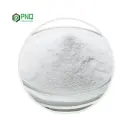Innovations in Red Pigments (foodaily)
-
Last Update: 2021-02-15
-
Source: Internet
-
Author: User
Search more information of high quality chemicals, good prices and reliable suppliers, visit
www.echemi.com
red usually means stopping, but when it comes to the category of natural color, that's not the case. Consumer surveys,ingredient innovations and distribution agreements have all clarified the choice of more food processors and beverage companies to use natural red and other natural red colors.Prinova
, based in Carroll Flow, Illinois, became
the sole agent distributor of
Lycored
's lycoprotein and
β
carotene in the United States and Canada in April
.
a third of U.S. consumers say they are interested in the idea of no artificial colors, accounting for
31 percent
and
43 percent of the younger generation of parents, according to market research data from Mintel
.
, commercial director of Prinova
's food and beverage division, said
's production of food free of artificial colors will be a market trend that will drive the industry.
prinova
customers no longer need synthetic pigments and carpent reds, so we need to find suppliers that use natural ingredients,vertical integration, and high creditworthiness to meet customer needs., he said:
We are delighted to be a new partner with
Lycored
, which will allow us to offer high-quality lycoprotein and
β
carotene to the market.
”Lycored
lycored offers lycoprotein as well as orange and dark red pigments from the natural
β
carrot pigment range at its branch in Orange, New Jersey.
, vice president of
Lycored, said:We use natural colors in red and pink to replace some artificial colors, such as
Red 3
. Natural
β
can successfully replace carotene
such as
Yellow 5 and synthetic carotene.Kalsec, based in Kalamazoo,
,
has made significant progress in extracting natural pigments.
has recently expanded our range of sources of high-quality natural red pigment, including phosphate, lycope and beet," said
Gary Augustine
, executive director of marketing at
Kalsec
. With
Kalsec
's unique
Durabrite
color stabilization technology, these red pigments are more stable for external lighting, heat or
pH
and maintain good color over a longer storage period.
”Durabrite
colors help maintain the desired color and flavor quality while inhibiting carotene oxidation and quality degradation.
Kalsec
extracted from the selected raw materials and incorporated them into the company's stable system to produce
Durabrite
colors. lycope from tomatoes can be used to make red colors Consumer research released last year by
Kalsec
shows that in countries such as the United Kingdom and the United States, more than
80 percent of parents of
3-12 -year-olds say they prefer to buy products that contain natural colors rather than artificial colors for their children. In addition,
70 percent
parents surveyed said they were even willing to pay higher prices for natural pigments. addition to red,
β-
can also extract natural orange pigment. Last year, Cohanson introduced the
CapColors
,
Orange 057 WSS
colorant, which provides beverage manufacturers with capsuled
β-
carotene. The company claims that because the new pigment component is in liquid form, it can be stabilized enough when acoustic, light and thermal conditions change, and can be dispersed and dissolved quickly.
Thornminger
, senior vice president of marketing at
's natural pigment division, said:
We put a lot of effort into promoting
CapColors Orange
, which is fortunately popular in every region." We are greatly encouraged by the growing interest of our customers. The product has been on the right track since it was put on the market, and the market has clearly seen the value of our new concept. We will continue to add a range of new features to our products in the coming months, including the use of non-juice substations.
” Cohanson
, said its natural pigment production division in Hosholm, Denmark, had achieved
22% revenue growth in the first half of the fiscal year
Overall, Cohanson's organic products grew by 13% in the first half of
year
. Based on its results for the first half of the fiscal year, the Company raised its full-year organic product revenue growth forecast to
10%-12% from
9%-11%
. "
's natural pigment products will continue to perform well among various market strategies and regions, with higher revenues. Shifting interest to natural pigments will drive our growth in North America. When the industry's benchmark companies pledge to the public that they will phase out the use of artificial colors to revitalised their brands, they will pay off in the market.
” In another innovation at Watson in Connecticut, they developed a new way of producing pigments
,
extracts Arabic gum from a tree to make edible flash products, or obtains natural colors from sources such as Chinese cabbage, algae, carrots, turmeric and mamwood. can be added or sprinkled with edible sparkle pigment on the candy surface during the candy cooking process. Because it does not contain sugar, artificial sweeteners, fat or hydrogenated vegetable oils, it has little taste or neutral taste, not sweet or salty. production of this glitter pigment helps companies better take advantage of the current trend toward safety and nature, Watson said. "
consumer demand for products with clean labels and no artificial coloring has opened the door to opportunity. Consumers are looking for safe and healthy products they can trust that do not contain artificial chemicals. In addition, they expect the same food quality, flavor and visual appeal. This challenges the traditional confectionery, food and beverage and baking industries, but it is an opportunity for companies that can meet these requirements.
” In order to gain a better understanding of consumer rights,
GNT
Group
1
2
12
in the New York State office surveyed
5000
people aged
18-70
, distributed in China, the United States, France, Germany and other countries. beets may also be used to develop red colors survey found that
54% of
global consumers expect their food and drink to contain only natural pigments. the
"natural "
and
"
colored vegetables and fruits
"
is considered to have more than
75%
credibility. GNT
group uses physical methods such as squeeze-crush screening to create color concentrates for eatable wild fruits to color, without artificial additives, chemicals or organic solvents. discussions about artificial pigments are now focused on whether they are related to ADHD in children. The U.S. Food and
Drug Administration raised the issue in a report published in March
,
, 2011 and denied the hypothesis of a causal relationship between pigment and ADHD in children. However,
FDA
added in
2011
: "The
"
data suggest that for some children who are susceptible to ADHD or other problems, their physical condition may be exacerbated by a certain amount of substances in their food. This quantitative substance does not include more than just artificial additives.
” C.S.P.I.
continued to warn people to be wary of foods labeled
artificial
in 2016, based on public interest concerns.
C.S.P.I.
a letter
fda
15 March. "
letter is a further demonstration of our previous petition
-
banning the use of synthetic pigments in food, as well as our previous demands on food producers and sellers. We ask them to at least provide consumers with warning labels describing the link between synthetic pigments and children's behavioural problems.
" C.S.P.I.
said:
"
we have received
parents from
2008
. These complaints are mainly about the negative effects of artificial pigments on their children and their families.
” The source of this
is
food, if reproduced please indicate the source, violators must be investigated.
This article is an English version of an article which is originally in the Chinese language on echemi.com and is provided for information purposes only.
This website makes no representation or warranty of any kind, either expressed or implied, as to the accuracy, completeness ownership or reliability of
the article or any translations thereof. If you have any concerns or complaints relating to the article, please send an email, providing a detailed
description of the concern or complaint, to
service@echemi.com. A staff member will contact you within 5 working days. Once verified, infringing content
will be removed immediately.







